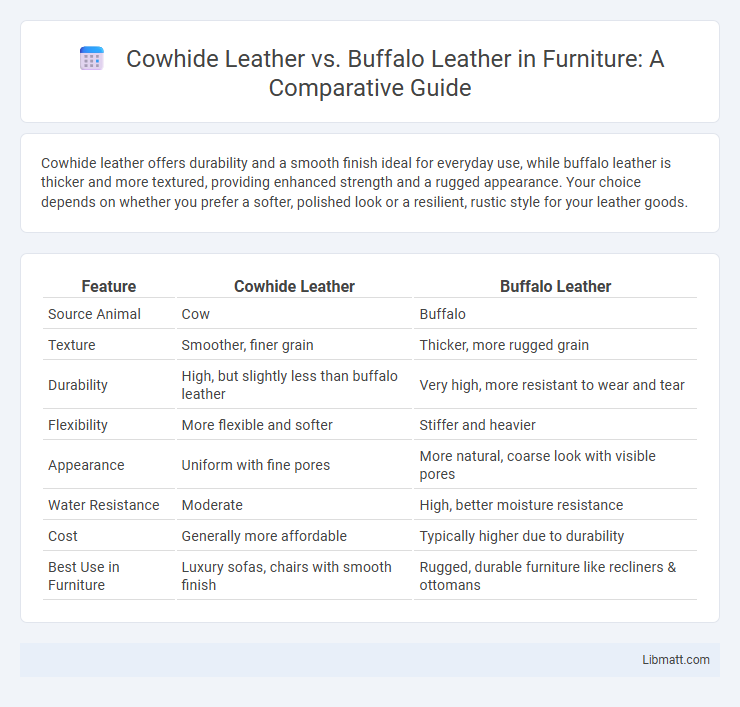Cowhide leather offers durability and a smooth finish ideal for everyday use, while buffalo leather is thicker and more textured, providing enhanced strength and a rugged appearance. Your choice depends on whether you prefer a softer, polished look or a resilient, rustic style for your leather goods.
Table of Comparison
| Feature | Cowhide Leather | Buffalo Leather |
|---|---|---|
| Source Animal | Cow | Buffalo |
| Texture | Smoother, finer grain | Thicker, more rugged grain |
| Durability | High, but slightly less than buffalo leather | Very high, more resistant to wear and tear |
| Flexibility | More flexible and softer | Stiffer and heavier |
| Appearance | Uniform with fine pores | More natural, coarse look with visible pores |
| Water Resistance | Moderate | High, better moisture resistance |
| Cost | Generally more affordable | Typically higher due to durability |
| Best Use in Furniture | Luxury sofas, chairs with smooth finish | Rugged, durable furniture like recliners & ottomans |
Introduction to Cowhide and Buffalo Leather
Cowhide leather comes from the hide of domestic cows, known for its durability and smooth texture, making it popular in upholstery and fashion. Buffalo leather, sourced from water buffalo, is thicker and coarser with a rugged grain pattern, offering enhanced strength and resistance to wear. Both materials provide unique characteristics suited for different applications, with cowhide favored for softness and buffalo leather valued for toughness.
Origins and Sources of Cowhide and Buffalo Leather
Cowhide leather is primarily sourced from domesticated cattle breeds raised globally for meat and dairy, with major origins in countries like the United States, Brazil, and India. Buffalo leather comes from water buffalo and wild buffalo species, predominantly found in South Asia, Southeast Asia, and parts of Italy, where these animals are also integral to agriculture. The differences in animal habitat and breed contribute to variations in texture, thickness, and durability of cowhide versus buffalo leather.
Physical Differences Between Cowhide and Buffalo Leather
Cowhide leather is generally smoother and finer-grained, featuring a more uniform texture, while buffalo leather displays a coarser, more rugged grain with pronounced natural markings. Buffalo leather tends to be thicker and denser, offering enhanced durability and resistance to wear compared to the comparatively softer and more pliable cowhide. Your choice should consider the specific physical traits you need, such as toughness for heavy use or a refined feel for aesthetic appeal.
Durability: Cowhide vs Buffalo Leather
Buffalo leather is generally more durable than cowhide due to its thicker grain and higher density, making it resistant to scratches and wear. Cowhide leather offers a balance of durability and flexibility, ideal for everyday items that require both toughness and comfort. Your choice depends on whether you prioritize rugged toughness or a softer, more pliable material for long-lasting use.
Appearance and Texture Comparison
Cowhide leather typically features a finer grain and smoother texture, offering a polished and consistent appearance ideal for refined leather products. Buffalo leather, on the other hand, presents a coarser, more rugged texture with pronounced grain patterns, lending a distinctive and durable look perfect for robust items. You can choose between cowhide for elegance or buffalo leather for toughness, depending on your preference for appearance and texture.
Flexibility and Comfort: Which Leather Wins?
Cowhide leather offers superior flexibility and a softer feel, making it more comfortable for prolonged use in garments and upholstery. Buffalo leather, known for its thick and robust texture, provides exceptional durability but tends to be stiffer and less pliable compared to cowhide. For products requiring comfort and ease of movement, cowhide leather generally outperforms buffalo leather in flexibility and overall wearability.
Water and Scratch Resistance: Performance Analysis
Buffalo leather exhibits superior water resistance due to its denser fiber structure, making it less prone to absorption and damage from moisture compared to cowhide leather. In terms of scratch resistance, cowhide leather often shows more visible surface damage, while buffalo leather's tougher grain pattern provides enhanced durability against everyday wear and tear. Both leathers benefit from treatments that improve resistance, but buffalo leather consistently outperforms cowhide in maintaining integrity under harsh conditions.
Common Uses in Fashion and Upholstery
Cowhide leather is widely used in fashion for durable footwear, handbags, and belts due to its toughness and smooth finish, while in upholstery, it offers a luxurious yet resilient surface for sofas and car seats. Buffalo leather, known for its coarser grain and increased thickness, is favored in rugged fashion items like jackets and heavy-duty boots, as well as in upholstery that requires extra durability and a unique textured appearance. Both leathers provide distinct aesthetic qualities and functional benefits, influencing their selection across diverse applications in the fashion and furniture industries.
Price and Market Availability
Cowhide leather generally commands a higher price due to its widespread demand and versatile applications in fashion and upholstery, while buffalo leather tends to be more affordable but less commonly found in mainstream markets. Your choice may depend on availability, as cowhide's greater supply ensures easier access in retail and online stores, whereas buffalo leather is often sourced in niche markets or regions with large buffalo populations. Market trends show cowhide dominates due to its consistent quality and variety, making it a staple material for consumers seeking both luxury and durability.
Choosing the Right Leather: Final Verdict
Cowhide leather offers a smooth texture and high durability, making it ideal for fashion accessories and upholstery that require a refined finish. Buffalo leather boasts a coarser grain and superior toughness, suitable for heavy-duty products like rugged boots and durable bags. Selecting the right leather depends on the desired balance between aesthetic appeal and functional strength, with cowhide favored for elegance and buffalo leather excelling in resilience.
Cowhide leather vs buffalo leather Infographic

 libmatt.com
libmatt.com